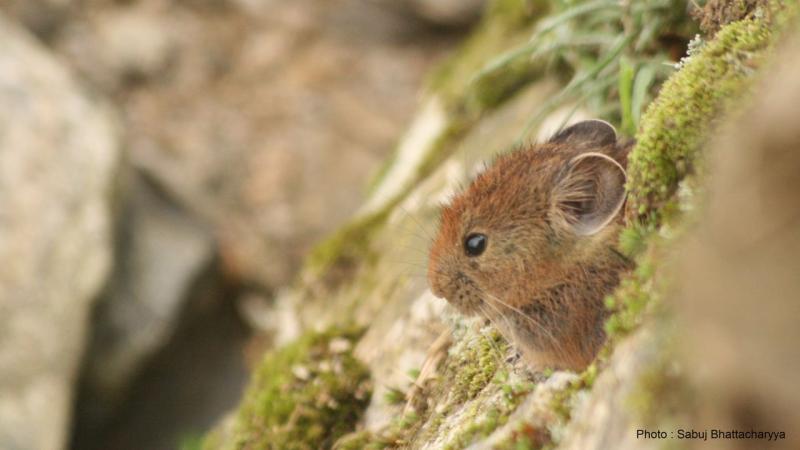
The changing climate across the world is ringing alarm bells with its devastating effects on all life forms and their habitats. The crown of India, the Himalayas, a biodiversity hotspot famous for its climatic and altitudinal variations is not spared from these effects! There are about 10000 species of plants in the Himalayas, and about 3000 of them are endemic, found nowhere else. Most of the 300 species of mammals found in the Himalayan landscape are exclusively adapted for the mountain habitat and are the verge of calamity should the landscape and climate change. However, now that climate change is real and the habitats are changing, how are these animals and plants responding?
In a new study, researchers from the Indian Institute of Science (IISc), Bengaluru, and the University of Sheffield, UK, have studied how smaller herbivores, like the Royale’s pika (Ochotona roylei), are being sensitive to the alarming changes in the global climate. Pikas are known to be vulnerable to climate change in places other than the Himalayas, where there are reports of American pikas going extinct in the northwestern parts of the United States due to changes in the climate. The current study is published in the Journal of Molecular Ecology and is supported by the Commonwealth Professional Fellowship, DBT Research Associate programme and the Wellcome Trust-DBT India Alliance.
Most of the Himalayan vegetation today consist of C3 plants that thrive in wet, cold climate and higher elevations. They photosynthesise by absorbing carbon dioxide from the air and converting that into sugars. As temperatures increase, there is a looming risk that another class of plants, called ‘C4 plants’, which are best suited for hot and dry climate, could replace them. The C4 plants have a different photosynthesis process where they use the carbon dioxide bound to sugar rather than absorbing it from the air. Hence, the loss of C3 plants not only affects plant diversity but also has detrimental effects on herbivores who exclusively rely on these plants for their diet.
The researchers of this study started off by analysing the dietary composition of the Royle’s pika—small herbivores related to rabbits and play an essential role in the food chain of the mountain ecosystems. They are often eaten by many carnivores and raptors, especially during winter when all other rodents hibernate.
The study found that the diet of pikas included more than 70 genera of plants, out of which around 60% were endemic to the Himalayas. More than 90% of the analysed dietary plants of the Royle’s pika are found to be alpine C3 plants. “Pikas prefer C3 plants which are mainly herbaceous and are rich in nitrogen and moisture with low amounts of fibre”, says Dr Sabuj Bhattacharyya, the lead author of the study, talking about the findings. The researchers have non invasively estimated the dietary composition by collecting faecal samples of the Royle’s pika after which they have analysed them using a modern method called DNA metabarcoding.
“DNA metabarcoding can be very useful in diet analysis as it is often difficult to note down all the possible diet items through visual observation or faecal samples. This method allows us to combine the amplification product for multiple genes belongs to a large number of samples and sequence them simultaneously. This method can generate a very high amount of data even with very low-quality DNA samples such as faecal samples”, explains Dr Bhattacharyya.
How then would the pikas react to the changing climate? “Pikas are cold-adapted species and are now restricted to high elevation areas. If the climate in these elevations become hot, they would want to move to higher elevations to find a suitable habitat. However, in several mountains regions they are already on the top and have no place to go”, says Dr Bhattacharyya. “To survive, they either have to go down and find alternative habitats in other taller mountains or die. If they choose to go down to find other habitats, they will face challenges like hot environment, lethal heat stress, high predation risk, and the lack of food ”, he says.
When the pikas’ diet falls apart, it isn't just the loss of pikas! With the current rate of climate change predicting a reduction from 24 to 42% in endemic plant species in the Himalayas by 2080, there is so much more to lose! “The Royle's pika is classified as ‘least concern’, but my previous studies show that they are also sensitive to changes in snow or temperature like their American cousins, acting as indicators of climate change. The loss of pikas from food web will result in the breakdown of the entire food web in the alpine region”, warns Dr Bhattacharyya.
The study highlights just one aspect of the damage that the changing climate could bring in for the Himalayas. “Pikas are becoming a victim of climate change due to anthropogenic activities. If we do not accept the fact that climate change is real, and work together to mitigate its impact, then we might also lose our habitats/home like the pikas”, says Dr Bhattacharyya.
The researchers also emphasise the need for more such ecological studies on the effects of climate change in the battered Himalayas. “The Himalayans has not received much attention for long-term research to understand which species are already facing the negative impact of climate change. In general, the changing climate is predicted to bring in changes to the temperature and precipitation in this region. Hence, there are many more that would be affected by the resulting heat stress, change in food availability and increase in disease susceptibility”, says Dr Bhattacharyya, before signing off.
